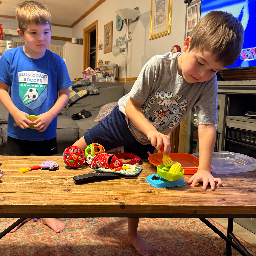How to Babysit a Difficult Child (4 Steps to Success)


Written & Illustrated by
Matthew James Taylor
Kidsit Founder, General Manager

Medically Reviewed by
Gina Maria Jansheski, MD, FAAP
Board-Certified Pediatrician, Medical Reviewer
Key Takeaways
- Difficult children often test boundaries - but consistent structure and routines help reduce resistance and tantrums.
- Maintain your authority: set clear rules, follow through with consequences, and avoid power struggles.
- It’s important to keep things fun and engaging - planned activities help, and giving kids notice about transitions reduces upset.
- Stay positive: your attitude makes a big difference. Kids pick up on frustration, so keeping calm and respectful helps improve behaviour.
- Difficult situations like bedtime or leaving the playground are easier if you prepare the child (warnings, calming down period) and follow through with what’s agreed.
- Because working with difficult children takes extra effort, it can be reasonable to charge a higher rate.
Babysitting obedient, calm children can be an absolute dream job. When they’re not so obedient and calm, you might start to really not enjoy your job.
But before you have a nervous breakdown and quit, read through this article for a few proven tips that will keep you in control and the kids happy. Learning how to deal with difficult children is a worthwhile skill to learn, and it might open up a few extra well-paying jobs for you that others aren’t willing to take.
So here's what to do.
The four steps to babysitting difficult children:
- Step 1: Maintain Structure & Routine
- Step 2: Maintain Authority
- Step 3: Maintain a Fun Atmosphere
- Step 4: Maintain a Positive Attitude
To be clear, this is not an article discussing the care of children that are difficult because they’re not feeling well. If that’s the information that you’re after, then read my article: How to babysit a sick child for help with that.
The Challenge of Difficult Children
People use different names when referring to these kids. Some call them “spirited children.” Others refer to them as “strong-willed.” Some call them “demons.” I’d really recommend you avoid using that last term.
Either way, these are the kids that tend to not listen. They throw tantrums. They have passionately strong emotions. They’re contrary and relentless. It’ll feel like a constant power struggle when you’re caring for them, and you might find yourself losing that fight much more often than you’d like.
There are actually lots of approaches to help in handling these children. In this article, we’ll go over the common, universal threads in all these methods that will keep the kids happy and you in control.
Introducing the four steps to success:
Step 1: Maintain Structure & Routine
Deep down inside, kids love structure. When they’re not completely used to it, it might seem that they don’t. When children are exposed to a well-structured routine, they thrive, and their behavior is noticeably better.
Why It’s Hard
Lots of kids simply aren’t used to structure. They might be more accustomed to having complete freedom to do what they want when they want to do it.
The result is an overtired, overindulged, bratty little kid that doesn’t think he needs to listen to anyone.
Maintaining structure takes a lot of effort on your part! Making a plan and sticking to it means thinking ahead and following through, even when things get rough. That might seem exhausting, but do you know what’s even more taxing? A child with bad behavior.
One of the major challenges with this is that, since many children aren’t used to having structure at home, it could be on you to introduce it for the first time. It might seem like a battle of wills in the beginning, but if you execute it properly, it’s actually not that hard.
Don’t dismiss any kid as simply being “bad.” Some are more intense than others, but even the wildest of personalities can be calmed and redirected positively. Regardless of the child, it’ll be up to you to maintain structure in a way that the child can benefit.
How to Apply It
The primary aspect of successfully establishing structure is that you need to give the kids advance notice of any activities or changes. For example, you might want to write out a schedule of planned activities on a whiteboard or post it on the fridge.
If the kids aren’t able to read yet, maybe draw out pictures of the schedule instead. Draw a playground, then a TV, then a game, then lunch, etc., so they’ll know the order of events. This will help them to avoid frustration.
Why is that?
If kids don’t know what’s going on, they might feel like you’re just telling them what to do on a whim. It presents a “because I said so” type of authority, instead of keeping them in the loop.
More than that, they’ll be mentally prepared for a change. If the kids are in the middle of ferocious playing and having the time of their lives, there’s going to be a guaranteed meltdown when you abruptly tell them to stop and that it’s time for something else. If the next activity isn’t preplanned, they’ll likely argue about what they want to do next.
Here are a few ways that you can incorporate structure into your childcare:
- Give five-minute warnings when you’re about to change activities.
- Incorporate “cool-down” activities; don’t have a high-energy activity (like tag) immediately followed by a very quiet one (like nap time). Choose a calmer activity (like drawing) in between to help the children adjust to the next one.
- Go over the schedule together at the beginning of the day so that the kids will know what’s in store.
- Post a list of the planned activities in a visible place, and remind them of the schedule several times during the day.
- Avoid letting children determine the daily schedule, but do let them give their input. Ask them toward the end of the day for ideas about what they would like to do next time, along with what they enjoyed and didn’t like as much.
While structure is very important, there are a few occasions where you’ll have to throw the plan out the window. For example, if a child is starting to feel sick, going out to the park might not be a good idea. Instead, maybe a calmer indoor activity would be more appropriate, like working on a puzzle, reading a story, or watching a movie.
Step 2: Maintain Authority
Kids love to test the boundaries, and spirited children have usually developed this into an art form. If you can’t maintain authority, they’ll walk all over you.
Why It’s Hard
Children constantly look for opportunities to be in charge. The problem with this is that children are not little adults. They don’t know what’s best for them, so they’ll generally end up making decisions that lead them to feeling sick, exhausted, and cranky.
If you’re not able to maintain authority, the child will be much more likely to throw tantrums and do whatever it takes to “win” a disagreement or get their way.
How to Apply It
The key to remaining in charge of the situation is consistency. This doesn’t mean you have to firmly decline every request the kid makes, but it needs to be clear that the decision is ultimately yours and will be respected. If you say no, the answer is no, and it stays that way.
If a child is having behavioral issues or difficulty making transitions, using the counting method works wonders. This is when you count to three, and if the behavior isn’t better by the time you reach three, consequences will happen. No delays, changing your mind, or giving in. It only takes a few times for the kids to clue in if you’re maintaining consistency in your response and doing it correctly.
Failing to Assert Authority
Here’s an example of a common scenario in which caregivers go wrong with the counting system:
Babysitter: “It’s time for bed. Please brush your teeth.”
Child: “No. I want to watch a show. I don’t want to go to bed.”
Babysitter: “I gave you a five-minute warning; it’s time to brush your teeth.”
Child: (ignores babysitter)
Babysitter: “One.”
Child: (still ignores babysitter)
Babysitter: “You have to brush your teeth. It’s time. Two.”
Child: (continues defiantly ignoring the sitter)
Babysitter: “If I say three, you know that you’re going to have a time-out.” (This is where the authority derails.)
Child: “I’m not brushing my teeth.”
Babysitter: “Two and a half.” (You basically have no authority at this point. The kid knows he’s in control.)
Babysitter: “Two and three quarters.” (You might as well stop talking and go away at this point. You’ve lost.)
Babysitter: “You need to brush your teeth. If you don’t get ready for bed, you’ll have a hard time getting up for school tomorrow.” (You’re pleading. So it’s obvious who has the real authority.)
Successfully Asserting Authority
Here’s a better way to go about the counting method:
Babysitter: “It’s time for bed. Please brush your teeth.”
Child: “No. I want to watch a show. I don’t want to go to bed.”
Babysitter: “I gave you a five-minute warning; it’s time to brush your teeth.”
Child: (ignores babysitter)
Babysitter: “I’m going to count to three. If you’re not going to brush your teeth by the time I say three, you’re getting a time-out.”
Child: (still ignoring babysitter)
Babysitter: “One. Two.”
Child: (gets up and brushes teeth)
Don’t count excessively slowly. Usually, two seconds between counts is ideal. And definitely, don’t hesitate or give more time before saying “three.”
Don’t expect this to work like a charm right from the start. Especially for spirited kids, it might take a few time-outs for them to really understand how this system works and that you will follow through with the consequences you set.
Why Counting Works
Firm counting works because it clearly demonstrates that you’re the one in control. When you don’t slow down or let the child dismiss you, they’ll quickly realize that there’s nothing they can do to avoid the consequences of not listening.
By allowing them to stall or even completely ignore you, they’re in control. On the other hand, giving them a short and very specific amount of time to comply and then promptly administering discipline, you’re establishing yourself as the one in authority.
Notes on discipline: Keep in mind that you are not the child’s parent. Discipline is a topic that you should discuss with parents before you ever watch their children. They will tell you what works for each child and how to administer it. Don’t discipline children without their parent’s consent.
If the parents don’t want you to discipline the children, you still have options. For example, you could have a notepad where you write down their misdemeanors so that you can report them to their parents. This generally only works if the children are old enough to understand, and if the parents will consistently administer discipline once they’re home.
If they don’t, you might want to reconsider working for this family. It could be very difficult to establish any kind of authority with their children, whose behavior will likely become challenging.
When Counting Doesn’t Work
There is one instance in particular where counting (and subsequent discipline) is unlikely to work at all.
When a child is overtired, they might not have enough control over their emotions and bodies to comply. This is generally when you see easy meltdowns, and even the smallest things can set them off.
Children under 5 years of age usually need naps. Otherwise, they become overtired and their bodies get flooded with stress hormones, which makes self-control nearly impossible.
Even older children need some quiet time to be able to calm down and recover a bit. If their whole day consists of high-energy activities, they’ll have a really hard time maintaining good behavior.
If you want some tips and guidance on how to get a kid to bed, read through this article: How to get kids to bed when babysitting. It has a lot of proven advice on how to establish a routine, a cool-down period, and how to get even stubborn children ready to fall asleep.
Step 3: Maintain a Fun Atmosphere
Keeping kids cooped up or letting them watch TV all day is a recipe for disaster. Kids have a ton of energy that needs to be spent. Otherwise, they’ll be like a thoroughly shaken bottle of Coke, ready to explode at the first opportunity.
But even the most active kids are a joy to be around when they’re genuinely having fun. It’s definitely worthwhile to make sure that you’re maintaining a fun atmosphere when you’re babysitting.
Why It’s Hard
You need to apply yourself to this, and it takes energy to keep kids engaged! You might also run into issues like kids not being in the mood for something, or maybe they didn’t get a great night’s sleep, and they’re feeling cranky.
Ultimately, babysitting is a job that requires effort. If you’re sitting on the couch and texting your friends, you’re not doing a very good job. Your attention needs to be on the kids, and you have to engage them!
There are some occasions where this is particularly challenging, though. For example, you might also have to clean the home while you’re watching the kids. Or maybe you have to do the dishes after a meal. These are times when you need to be on the ball to keep the kids happy.
How to Apply It
It’s always a good idea to have a few things packed in your babysitting bag. These are the things that you can pull out to engage the kids when it seems like they’re getting off track.
Planning is also key. Maintaining a schedule and keeping the atmosphere fun go hand in hand. If you plan fun activities, the kids will look forward to the next thing instead of being concerned about stopping the activity they’re currently enjoying. This fun planning can help you keep your momentum from one activity to the next.
Here are some ideas for enjoyable activities you can schedule to keep even difficult children engaged:
- Take them to the park (see our guide).
- Playing easy outdoor games in the yard (tag, hide and seek, Simon says, or soccer).
- Painting.
- Puzzles.
- Crafts (macaroni necklace, melted crayon-shaving butterflies).
- Have a contest (paper airplane distance flying, card stacking challenge).
- Face painting (check out this guide)
- Dress-ups
If you want a ton of different ideas on how to keep loads of energy channeled positively, see our over 200+ things to do while babysitting.
Step 4: Maintain a Positive Attitude
Your attitude towards the kids and your job is going to have a major effect on how well the sitting job goes. Kids will pick up on a negative attitude very quickly, and they’ll most likely mirror it back at you.
On the other hand, a positive attitude is contagious! If you stay upbeat and encouraging, you’re much more likely to have happy, willing kids.
Why It’s Hard
Not all kids are pleasant. If you’re dealing with a difficult child, this can be really frustrating!
It can be hard to control your own feelings to the point of being able to handle a tantrum calmly, but this is absolutely critical, especially with challenging children.
How to Apply It
If you’re really struggling to like a strong-willed child, here’s an exercise that can help you focus on their good qualities instead of the negatives.
Write out a list of all the characteristics that you’d use to describe the child. If you’ve got a negative view of the kid, then it might be a long list of negative traits. Maybe it will look something like this:
- Whiny
- Wild
- Demanding
- Argumentative
- Stubborn
Now rethink these labels. How could these core characteristics be seen in a positive way? Let’s add the positive qualities beside the first set of labels:
- Whiny becomes “analytical.”
- Wild becomes “high energy.”
- Demanding becomes “holds high standards.”
- Argumentative becomes “assertive.”
- Stubborn becomes “strongly committed to goals.”
At first, this might seem like a stretch. But the more you use these positive labels with the child, the more your attitude towards them will change. And there is no doubt the kid will pick up on this, too.
If you’re using negative labels when you’re talking to them (like “stop being so whiny”), they’ll think that you view them negatively, and you don’t like them. And really, this could be the truth.
But if you use the more positive labels, it’ll change your relationship with them. They won’t feel judged or disliked, and you’ll have a much easier time being around them.
Particularly Challenging Situations and Tips on How to Deal with Them
Regardless of how well you apply these suggestions, there are some occasions where all bets are off. Here are a few of these tough situations and what you can do to avoid tantrums, meltdowns, and outright rebellion.
Bedtime
Knowing that the day has come to an end and the fun is over can be a horrifying concept for a young child to process. It may be a nightmare getting kids to bed if they’re the type that would rather fight to the point of physical collapse instead of submitting to sleepy feelings.
A successful bedtime really comes down to maintaining a good routine, keeping the kids in the loop about what’s going to be happening and when, and placing the focus on relaxation instead of the fact that they should be sleeping.
For very young children, like age 3 years and under, there are some extra challenges. Their bodies produce stress hormones when they’re overtired. This means that they may suddenly become hyperactive to the point that they are not able to control their bodies and stay still, no matter how hard they try.
Your goal is to prevent this from happening in the first place. The bedtime routine needs to begin before the children become overly tired. This will allow them to feel relaxed, and sleep will come naturally instead of by force, ferocious battle, and finally collapse.
For a detailed guide on getting kids to bed like a champ, you should take a close look at this article: How to get kids to bed while babysitting.
The Playground
When kids play intensely and are really wound up, it can be hard for them to calm down. They’re not like adults, who can quickly decide to stop what they’re doing and move on to the next thing.
Think of a kid’s energy like a freight train. It doesn’t stop on a dime. It can actually take several minutes to slow down.
So when you’re at the playground, it’s all about giving them every opportunity to slow down before moving on to the next thing, especially when it’s time to leave.
Five-minute warnings are an absolute must. But if the child is especially spirited and strong-willed, you might need to take it a step further. Here’s an example of how to handle it:
- Announce the five-minute warning that you’ll be leaving the playground. You’ll likely notice that they’ll be very disappointed, but a meltdown at this point is unlikely. For those odd times that there is a meltdown this early, just remind them there are still five minutes left, and they still have time to play.
- Give them a three-minute warning. At this point, remind them of what you’re going to be doing next. This will shift their focus from their current activity to what they’re going to do.
- In the last minute, make sure that you’re playing with them. Try to do a more tangible count-down. For example, if you’re pushing them on the swing, tell them that there are ten pushes left. Have them count down with you.
If you prepare them this way, they’ll likely still be disappointed to leave the playground, but a complete meltdown is much less likely. Overall, that’s a definite win!
TV Time
This can be tricky because you need to have good timing. It’s reasonably easy to finish TV time at the end of a show, and nearly impossible to cut it off in the middle.
If you have a deadline for when they need to turn the screen off, then time the end of the show with that. Make it completely clear that there will be no more shows and remind them of what’s going to come next.
If the length of the show doesn’t correspond with the time that the screen needs to be off, try starting the show halfway through, or equal to however much time you need to shave off. You could also do this midway through the show.
If you’re watching Netflix or something else that will automatically move on to the next show, make sure that you’re ready to turn the screen off right away. If the next show starts, they’ll have a much harder time getting away from the TV.
What Age Is The Easiest To Babysit?
We polled our babysitters to find out:

You vs. the Parents
This is possibly one of the most difficult situations if you’re caring for a challenging child. Kids love to pit adults against each other, and they’re masters of manipulation.
If the parents don’t back you up, there is one thing that is guaranteed to happen: if you say something that they don’t agree with, they’ll instantly run to the parents and try to undermine you.
For example, if you say he can’t have a cookie, the kid will run to mom and ask her if he can have a cookie. He’ll leave out the fact that he already asked you, and you said no. If the mom says that he can have a cookie, then he’s undermined you.
It’s worthwhile to have a good talk with the parents about this. If you’re going to manage these kids, you and the parents need to be on the same page. There are generally two approaches that work:
The parents leave you in charge. If the child asks them for something, the first thing they ask is, “what did your babysitter say?” This will save everyone a lot of frustration, and it is the ideal situation for you.
Alternatively, this could also work: If the parents want to be the final authority, you’ll need to ask them for basically everything. So if the kid wants a cookie, tell him to ask his mom. Don’t let him pit you against each other. This isn’t the ideal solution since you’ll have a harder time establishing authority, but it still might work if kept consistent.
Ultimately, even the most difficult children can be managed. It will take a lot more effort, but if you can master these skills, you will become an even more qualified babysitter.
Charge More For Difficult Children
With difficult children, it's often acceptable to charge more than the average babysitting rate in your area due to the extra complexity with the job.
Average Babysitting Rate Per Hour By Country
(Calculated weekly from our live member data — Updated 21 Dec 2025)
| Country | Avg Rate |
|---|---|
| United States | $16.79 |
| Canada | $18.28 |
| United Kingdom | £11.38 |
| Australia | $26.97 |
| New Zealand | $22.35 |
Search for your exact location to get a more precise average pay.
Need some help with a crying child? Read our best strategies for How to Calm an Upset Child.
If you're finding success with a difficult child, don't stop there, learn how to nurture them to encourage and motivate them to be the best they can be.
Next:


























